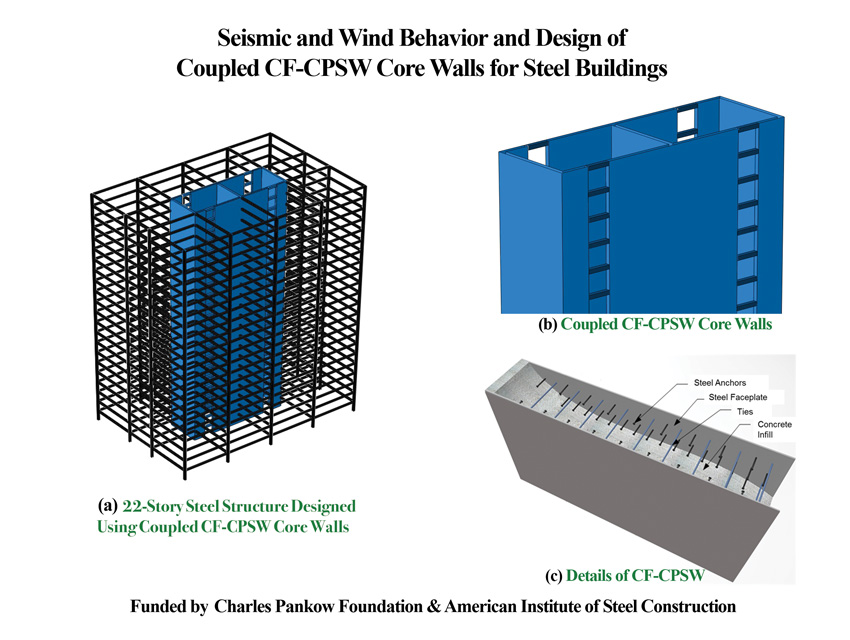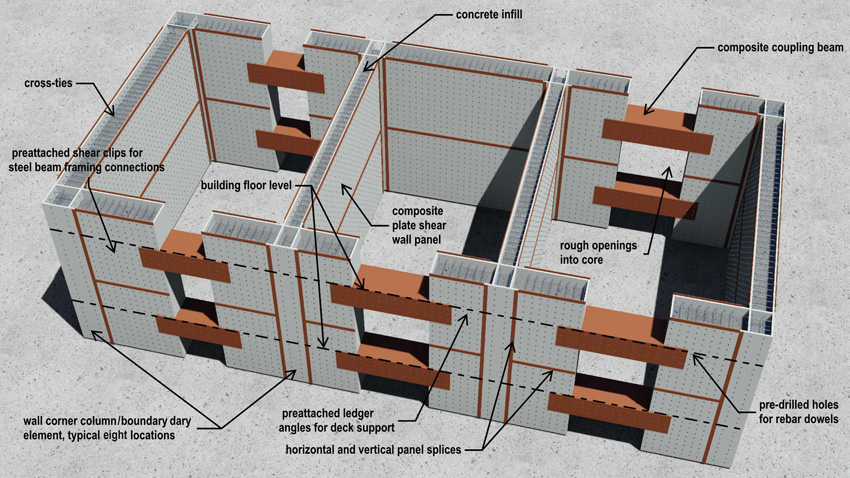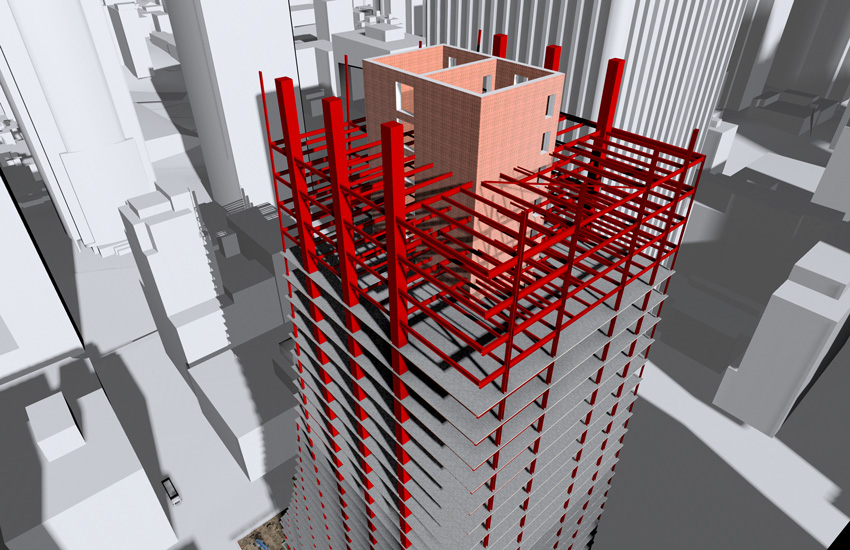Introducing the Steel-Plate Composite Core
Concrete-Filled, Composite Plate Shear Wall System
While these systems do offer advantages, it’s the above-mentioned newer application of the coupled-filled steel, composite plate shear wall (CF-CPSW) system for high-rise structures that is really turning heads.
Similar to how a reinforced concrete shear wall system functions, with a similar wall arrangement and thicknesses, with this newer system, the reinforcement is provided by the steel plates on the outside of the wall.
“The steel plate composite wall system is a natural evolution of the reinforced concrete wall system,” explains Varma.

Image courtesy of AISC
The coupled steel-plate composite wall system is a high-strength concrete shear wall sandwiched by two structural steel plates.
Looking at issues related to steel rebar congestion and concrete placement at the base of thick concrete walls in high-rise buildings, plus the time and effort needed for formwork placement, concrete casting, formwork removal, etc., the steel-plate composite wall system was a next step in structural evolution to address these concerns.”
As noted, the concept is currently used by U.S. nuclear structures and for missile and aircraft impact resistance. Similarly, the United Kingdom utilizes it for blast-resistant construction and Japan applies it for its nuclear structures as well.
Involved in creating standards for this system, the AISC funded a research project in 2011, which led to AISC N690-12s1, 2015, Specification for Safety-Related Steel Structures for Nuclear Facilities, and Design Guide 32: Design of Modular Steel-Plate Composite Walls for Safety-Related Nuclear Facilities.
Construction of the system involves crosstying two ½-inch-thick steel plates together with rods at 1 foot on center, both vertically and horizontally. Fabricated in the shop, the steel plate modules are then shipped to the job site and erected simultaneously with the structural steel framing.

Image courtesy of MKA
This cross section of the CF-CPSW design shows the composite plate shear wall panel, concrete infill, composite beams, and other details.
When the erection of two tiers (four floors) of the structural frame is complete, including installation of the steel plate modules, self-consolidating concrete fills the voids between the plates, bonding with the rods and plate to form a composite wall system. Thus, erection of the steel framing is a continuous operation with no internal reinforcing of the plates required.
Noted Benefits
Because the steel framing doesn’t have to wait for the concrete core, this significantly increases the speed of construction.
In fact, an MKA construction study of the Rainier Square project found that a concrete core building would take 474 working days to top out, as compared to just 377 working days for the hybrid wall building.
“The 97 working day difference equals 136 calendar days, which means the owner will benefit from four-and-a-half months lower contractor’s overhead and general conditions costs, four-and-a-half months lower financing costs, and four-and-a-half months of earlier rental income,” Klemencic explained in a presentation at Purdue University, where he recently received a distinguished engineering alumni award.
Another difference with the CF-CPSW system is that the rebar is positioned outside the wall. Furthermore, the formwork doesn’t have to be removed and instead functions as a part of the structural system.
In terms of structural performance, the system can achieve high reinforcement ratios without congestion and concrete placement issues.
“The structural stiffness, strength and deformation capacity of the composite systems are comparable or better than those of equivalent reinforced concrete systems,” states Varma. “The system leverages the advantages of both steel and concrete construction materials, where the concrete infill delays the local buckling of the steel plates and the steel modules confine the concrete infill to improve its ductility. Additionally, if needed, the system has the ability to provide excellent blast and impact resistance due to its dual steel plate armored design.”
Adding some more details, he relates that two or more steel-plate composite walls—which can be planar, C-shaped, or I-shaped in cross-section—are connected together by coupling beams at each story level.
“Under seismic loading, the coupling beams undergo inelastic deformations first and dissipate energy,” Varma explains. “Eventually, the base of the composite walls also undergo inelastic deformations and dissipate more energy.”
Furthermore, the coupling beams, which are rectangular steel box sections filled with concrete, enable the coupled core wall structures to resist lateral loads from wind or earthquakes by allowing the composite walls and coupling beams to bend together as a unit, he adds.
“Walls with steel plates have an enormous shear resistance,” Bruneau explains. “Concrete is nice in compression, but weak in tension and doesn’t perform well in earthquake situations. Because the steel is continuous, this ensures the continuing of the resistance of the shear forces.”
Yet another advantage is the fact that steel tolerances, per AISC standards, are tighter than the concrete tolerances set by the American Concrete Institute. With other hybrid systems, the steel framing beams connecting to the concrete core must be fabricated last because they can only be field measured for final dimensions after the concrete core walls poured, explains Lawrence F. Kruth, P.E., vice president of engineering and research, American Institute of Steel Construction, Chicago.
With the CF-CPSW system, steel connects to steel with no need for embedded plates, thereby eliminating tolerance issues and the challenge of overlapping trade issues. “The tolerance difference between the concrete cores and steel framing creates challenges in design, detailing, and construction that can be avoided with the sandwich walls,” confirms James O. Malley, S.E., group director and senior principal, Degenkolb Engineers, San Francisco.
The CF-CPSW is also considered to be a modular system, as the steel modules are manufactured in a shop and then shipped to site for assembly and concrete casting. “Prefabricated in the shop in accordance with specified tolerances, this reduces fit-up issues during erection between the steel framework and embed plates attached to the composite cores,” explains Varma. “This leads to better coordination between the steel fabricator, erector, and general contractor for the project.”
This continuity of construction is also advantageous for high-rise projects where outrigger systems are required for wind comfort as the steel outriggers easily connect to the steel plates, Malley adds.
All Eyes on Rainier
Considered a “proof of concept,” many structural engineers are watching Rainier Square as it prepares to rise up to its 850-foot apex as the world’s first high-rise CF-CPSW system.

Image courtesy of MKA
This Revit model displays the concrete-filled composite plate shear wall core system.
“Rainier Square is a very significant step forward for this system,” confirms Malley. “Having such a signature project will undoubtedly provide impetus for other projects to consider this as an alternative to a fully concrete core.”
Fortunately for MKA, the environment was ripe for such an innovation. For starters, the building owner, Wright Runstad, has a history of advancing design and construction through the adoption of new technology.
Klemencic says that Wright Runstad was the first U.S. developer to consider performance-based seismic design for a high-rise building. In fact, PBD was used for the Bellevue, Wash., Three Bellevue Center and is now the standard of the industry.
Furthermore, the City of Seattle tends to be more open than some U.S. cities when it comes to allowing newer approaches to building.
“Our openness to innovation provides an environment in Seattle that encourages and supports alternative designs, while our peer-review process provides a means for us to feel confident in the building’s expected performance,” says Cheryl Burwell, P.E., S.E., engineering and technical codes manager, City of Seattle.
Ultimately, the CF-CPSW system is expected to decrease project construction time by 20 to 40 percent and reduce general condition costs, overhead costs, and financing costs, reports Kruth. “Also, by completing the structure sooner, the owner will receive rental income months earlier than projected,” he says. “On this project, this could result in tens of millions of dollars in savings.”









